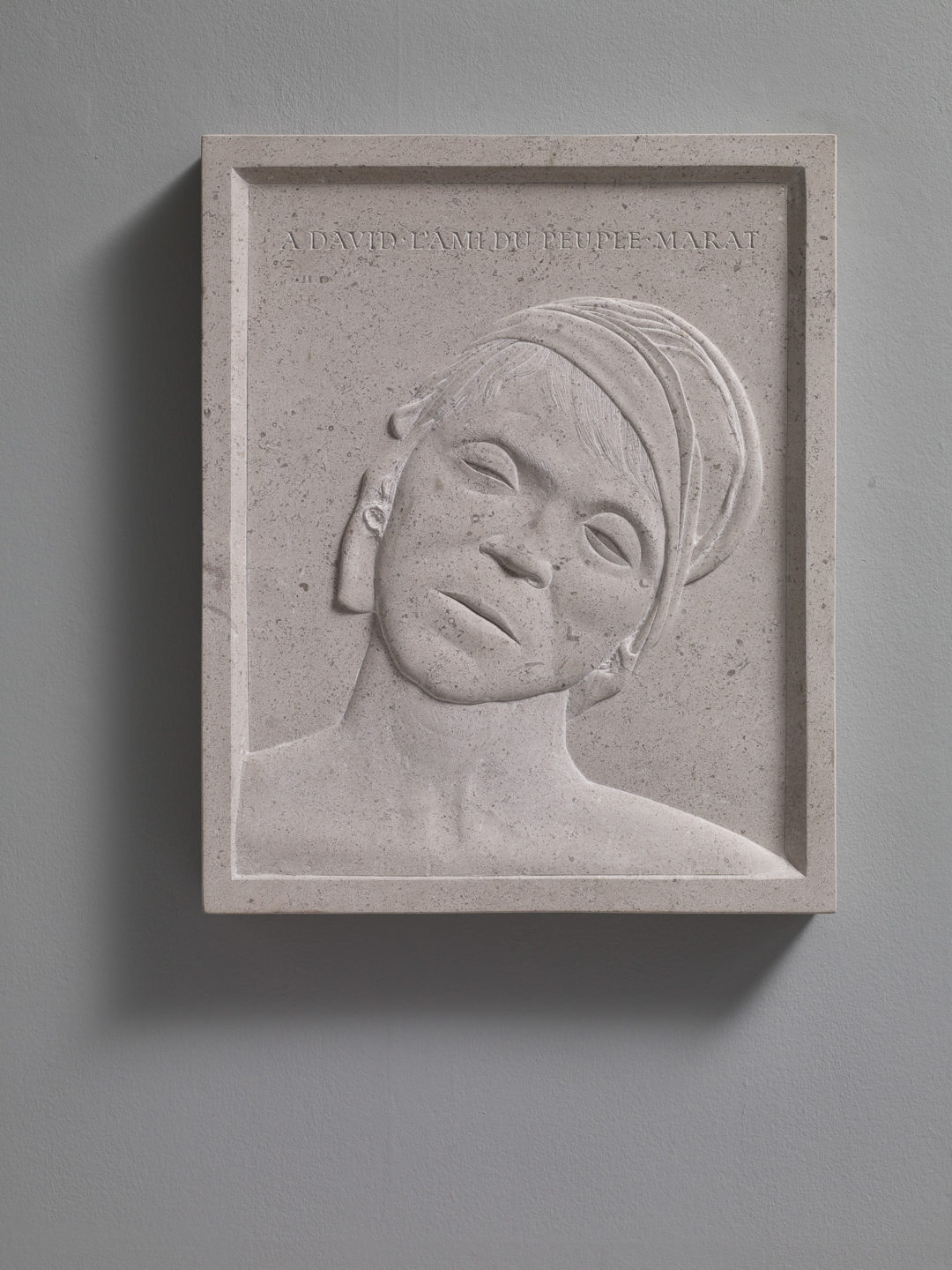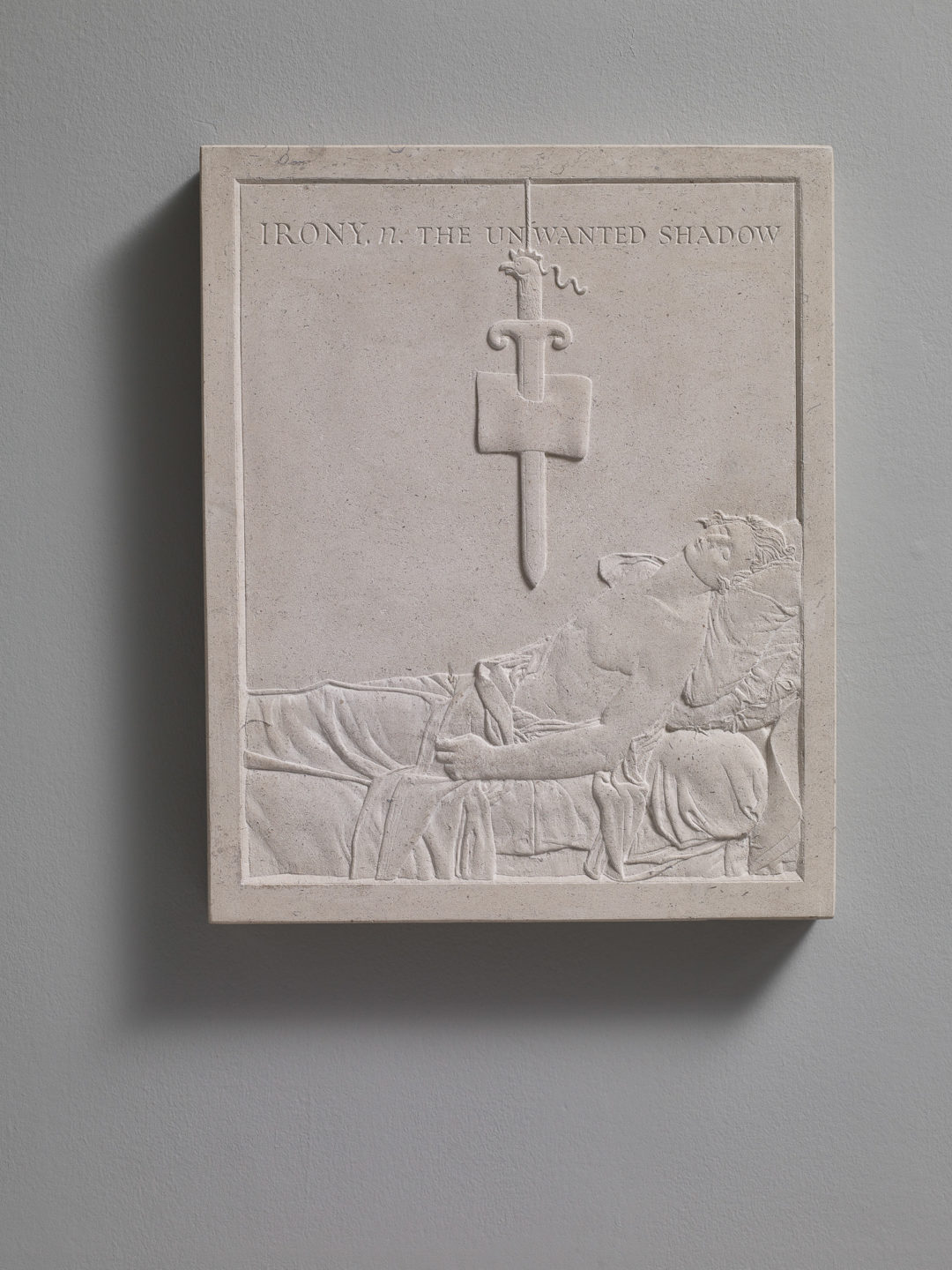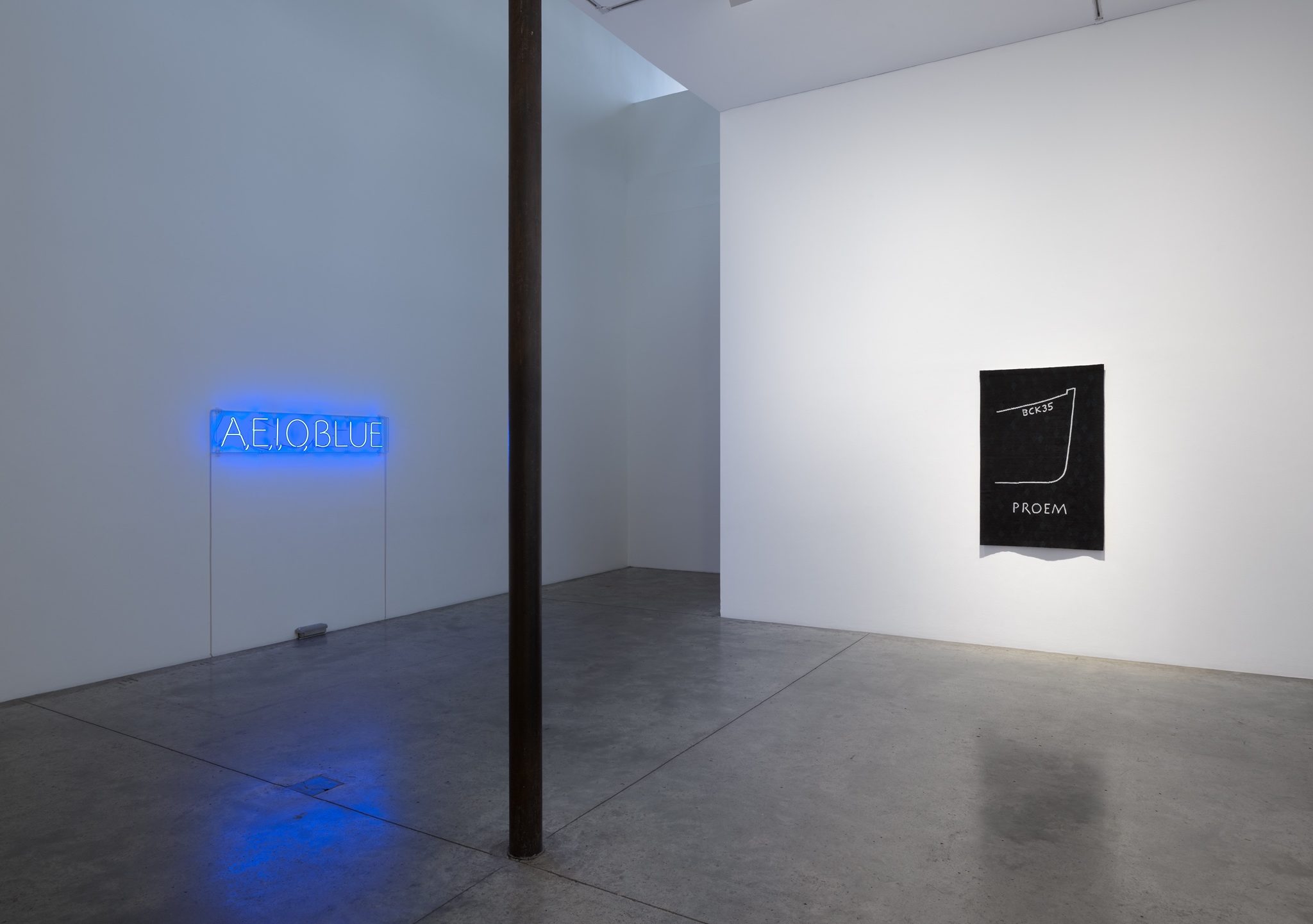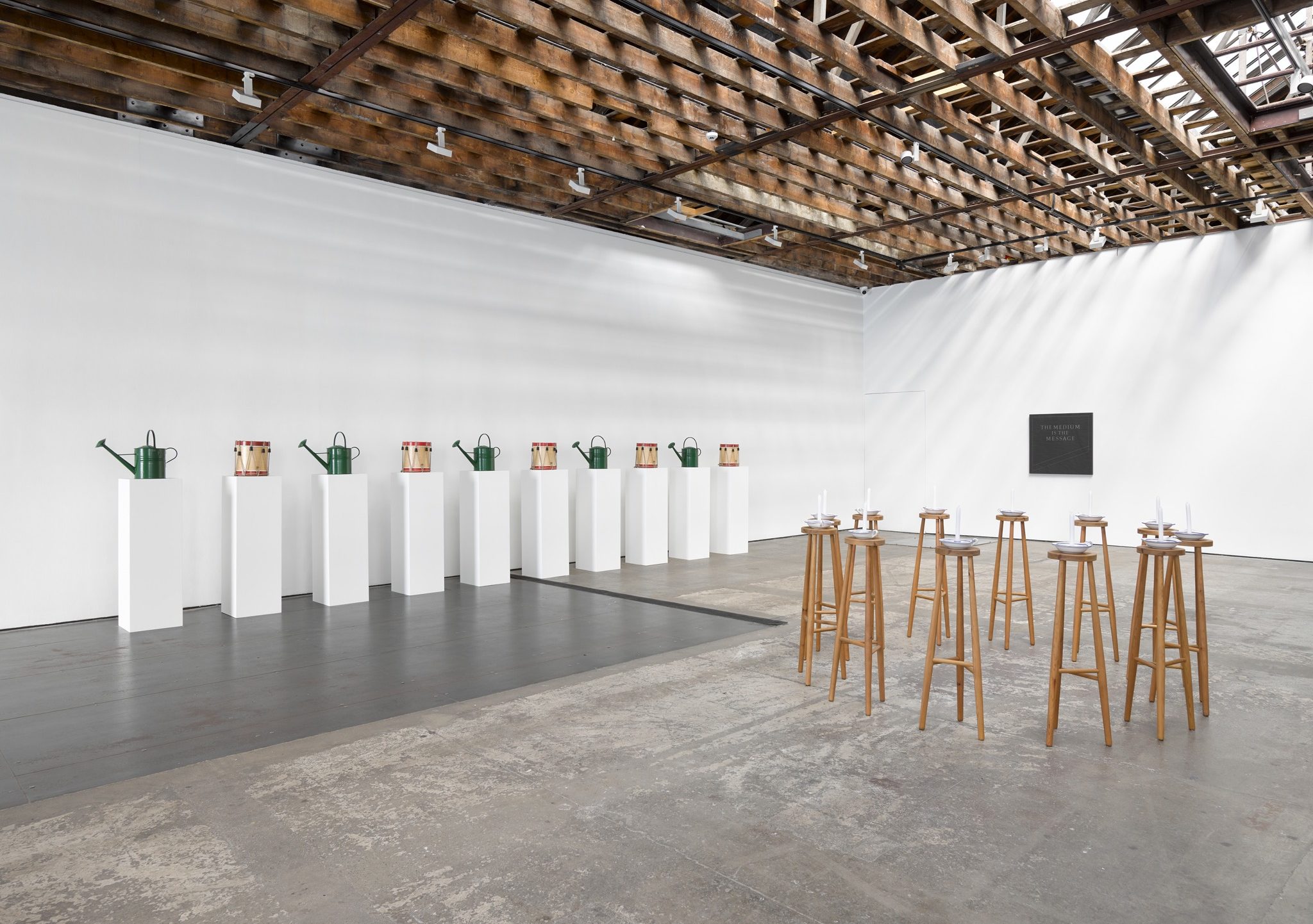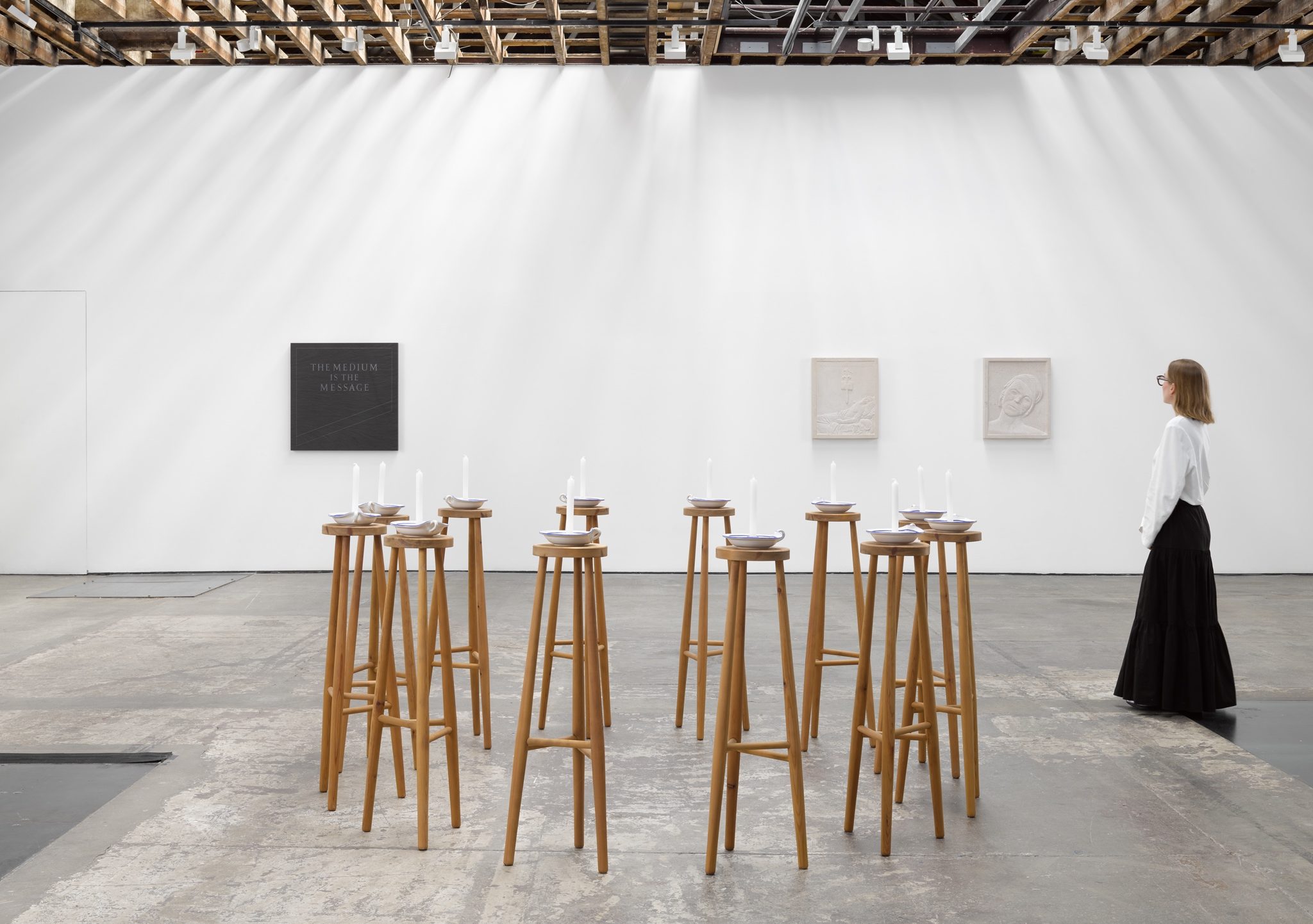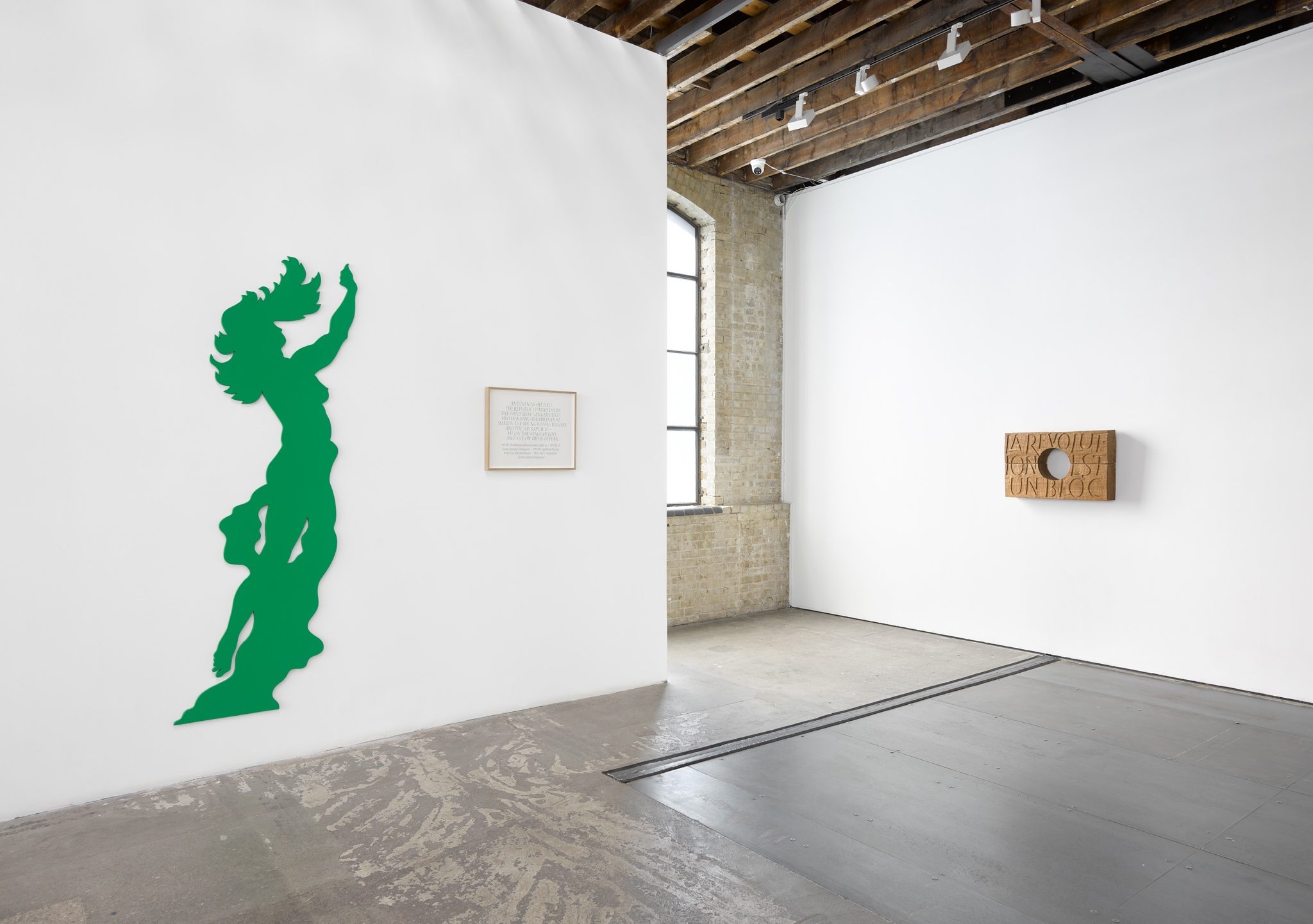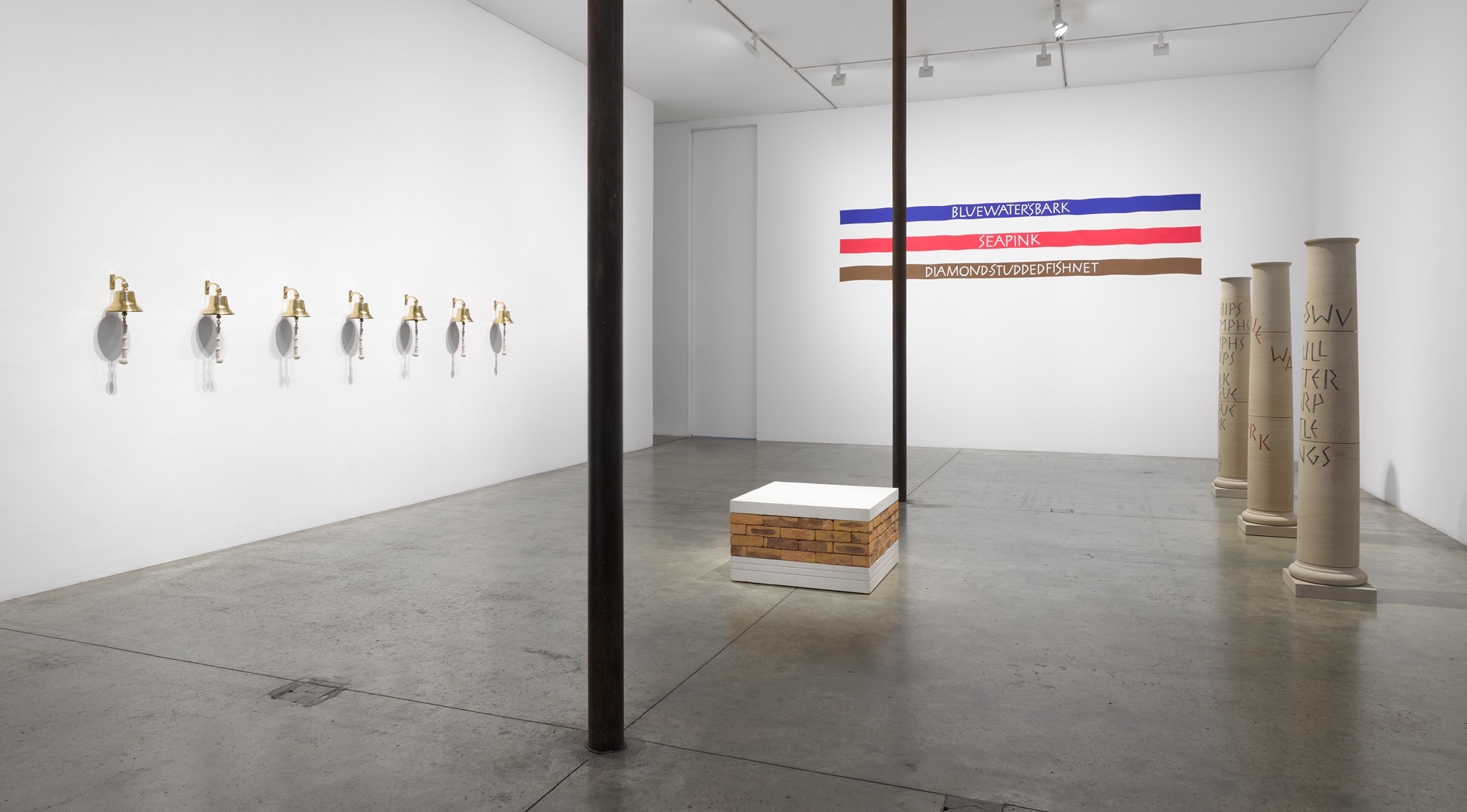
Ian Hamilton Finlay: Fragments
Exhibition: 30 April–24 May 2025
16 Wharf Road, London N1 7RW
Tuesday–Saturday: 10am–6pm
An exhibition marking the centenary of the birth of one of Scotland’s greatest artists, Ian Hamilton Finlay. Fragments is both a major new book and eight international exhibitions, curated and edited by Pia Maria Simig.
An artist, poet and landscape designer, Ian Hamilton Finlay (1925–2006) reinvigorated the classical tradition in a body of work that encompasses a variety of creative forms to celebrate the sustaining power of words.
He is best known for his garden Little Sparta, set in the Pentland Hills, near Edinburgh, where he lived and worked for the last 40 years of his life. He significantly influenced the concrete poetry movement, and his extensive printed poetical and graphical works were published by Wild Hawthorn Press, which he co-founded in 1961. His visual art work, achieved in collaboration with expert artists and craftspeople, can be found in museums, parks and gardens worldwide.
Drawn principally from the 1990s, and featuring sculpture in stone, wood and neon, as well as wall painting, tapestry and print, works on view at Victoria Miro are curated around the themes of ‘revolution’ and ‘maritime’.
Representing a moment of enormous political and aesthetic rupture and signalling a great moral as well as political leap, the French Revolution proved a rich subject for Finlay; he first received international attention for his guillotine installation A View to the Temple at Documenta 8 in Kassel in 1987 and thereafter the guillotine became one of the most enduring elements of his iconography. The late author, critic and artist Tom Lubbock commented, ‘A prominent (and to some, puzzling) theme of this period is the French Revolution. Finlay once explained its origins simply. His first public installations had been constructed to such low standards that he had thought, “We need a revolution. So I looked to see what revolutions there had been.” The (classically inspired) French Revolution, especially the Jacobin phase, became for Finlay the exemplary historical event. Its episodes, personalities and ideas provided the terms in which he framed his conflict with the contemporary world. It also embodied his tragic conception of politics, where idealism and catastrophe are inextricable.’
The sea and maritime themes such as boats, fishing and seafaring were recurring sources of inspiration for Finlay. He was born in Nassau, the Bahamas, and later, during the winter of 1955-56, lived on the small island of Rousay, Orkney, a location that inspired the symbolic landscapes of his later works.
Excerpts from the new book, Fragments, published by ACC Art Books on 8 May 2025 are featured below.
Finlay Laura Cumming quote 1
‘Finlay understood as few other artists the emotional power of letters cutting into form, shape and colour.’ — Laura Cumming, reviewing Ian Hamilton Finlay’s centenary display at the Scottish National Gallery of Modern Art
Among centenary commemorations for Finlay is a special display at the Scottish National Gallery of Modern Art, Edinburgh (on view until 26 May 2025). Reviewing it in The Observer, Laura Cumming comments, ‘His is an art of distillation, juxtaposition, thrift and contemplation. A poet before he became a concrete poet, a sculptor who became an “avant gardener”, as he put it, of that fabled landscape known as Little Sparta in the Pentland Hills beyond Edinburgh, Finlay understood as few other artists the emotional power of letters cutting into form, shape and colour.’
Finlay (The Medium is the Message)

Slate, with Nicholas Sloan
91.5 x 91.5 x 4 cm
36 1/8 x 36 1/8 x 1 5/8 in
Ian Hamilton Finlay, The Medium Is The Message, 1990
More info‘Finlay’s carving on stone of the slogan, “The Medium is the Message”, is an indication of ironic distance from the view that contemporary media have definitively superseded traditional modes of communication.’ — Stephen Bann, from the accompanying publication
About the above work, Finlay commented, ‘A simplified outline of the guillotine blade is inscribed on a piece of slate, with an appropriately riven finish. If the slate has a remote association with the blackboard, so the text, added not in chalk but in incised classical letters, has something of an air of instruction, correcting [if need be] our modern view of The Blade.’
Stephen Bann writes, ‘It is hardly accidental that one of the works included is a carving on stone of one of the sayings of Marshall McLuhan, the post-war media theorist. McLuhan heralded the end of the era that had opened with Gutenberg’s invention of the printing press. Finlay’s carving on stone of the slogan, “The Medium is the Message”, is an indication of ironic distance from the view that contemporary media have definitively superseded traditional modes of communication. The fact that Finlay involved in his work not only distinguished letter carvers, such as Michael Harvey, but also fine calligraphers such as Ron Costley, is another telling indication. Indeed the multiple connotations attached to the term “inscription” help to underline the ways in which Finlay became an exemplary artist, exceptional in his concern to infuse a classical serenity into the art of the contemporary world.’
Finlay (La Revolution est un bloc)
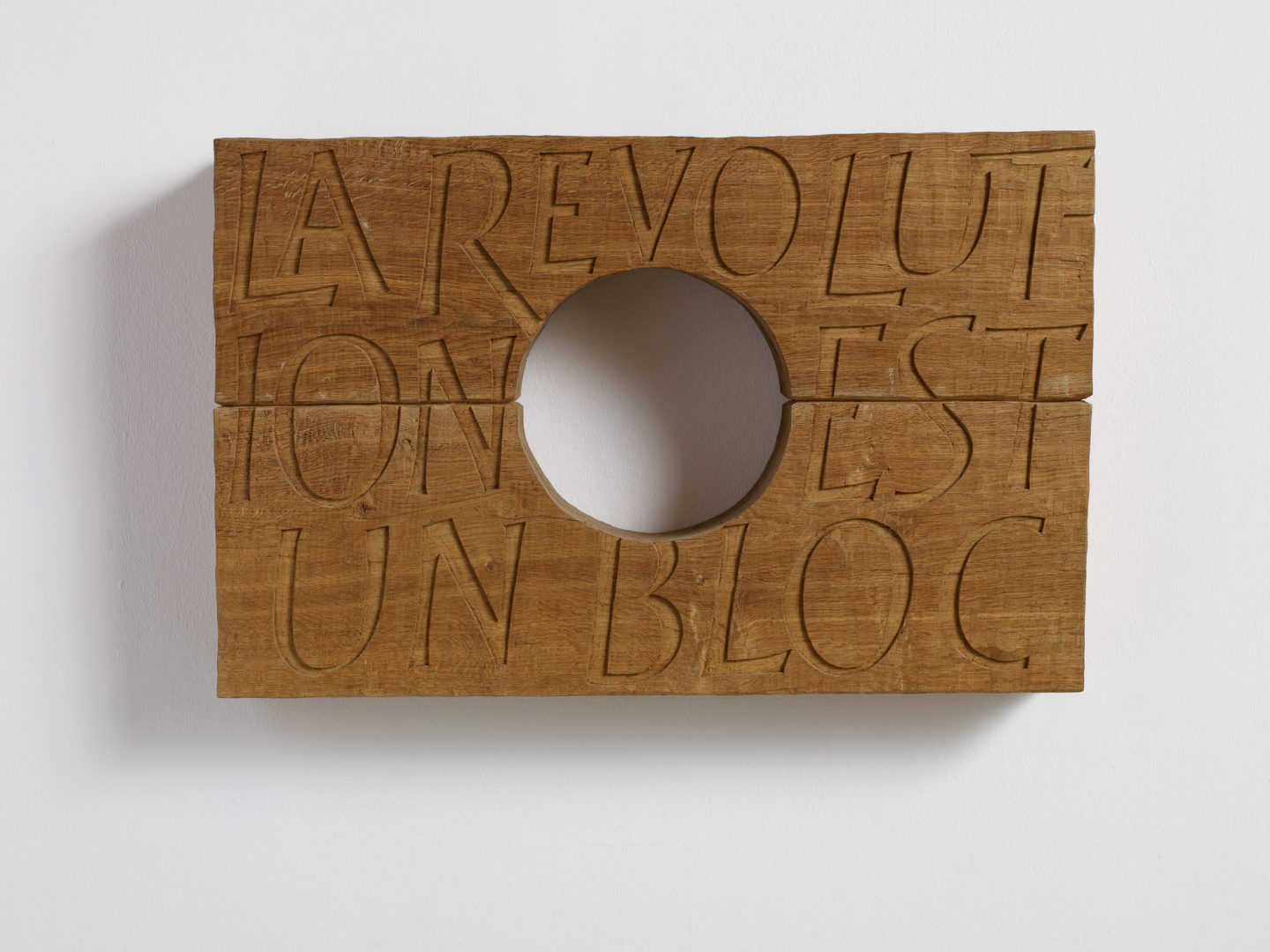
Wood, with Nicholas Sloan
55.3 x 81.3 x 15.2 cm
21 3/4 x 32 x 6 in
Ian Hamilton Finlay, La Révolution est un Bloc, 1992
More info‘The (classically inspired) French Revolution… became for Finlay the exemplary historical event. Its episodes, personalities and ideas provided the terms in which he framed his conflict with the contemporary world.’ — Tom Lubbock, from the accompanying publication
La Révolution est un Bloc, 1992 – a wooden block carved with the words of the title and a central aperture reminiscent of a guillotine’s lunette – alludes to advances in secular democracy and social progress, and the bloodshed and unrest brought about by the Revolution. Finlay wrote, ‘Properly translated, the French phrase, originating with Clemenceau, means ‘The Revolution is a unity’. But in English ‘bloc’ carries an echo of ‘block’ – the block of wood on which the victim to be executed laid his head. We can understand the mistranslation as an acknowledgement of the destructive role of the factions, so often noted by Robespierre and Saint-Just. Or we can take the darker view that conflict is [as it were] the guarantee of the sincerity, the piety, of the huge upheaval.’
Finlay (12/1794, 1994) Candles
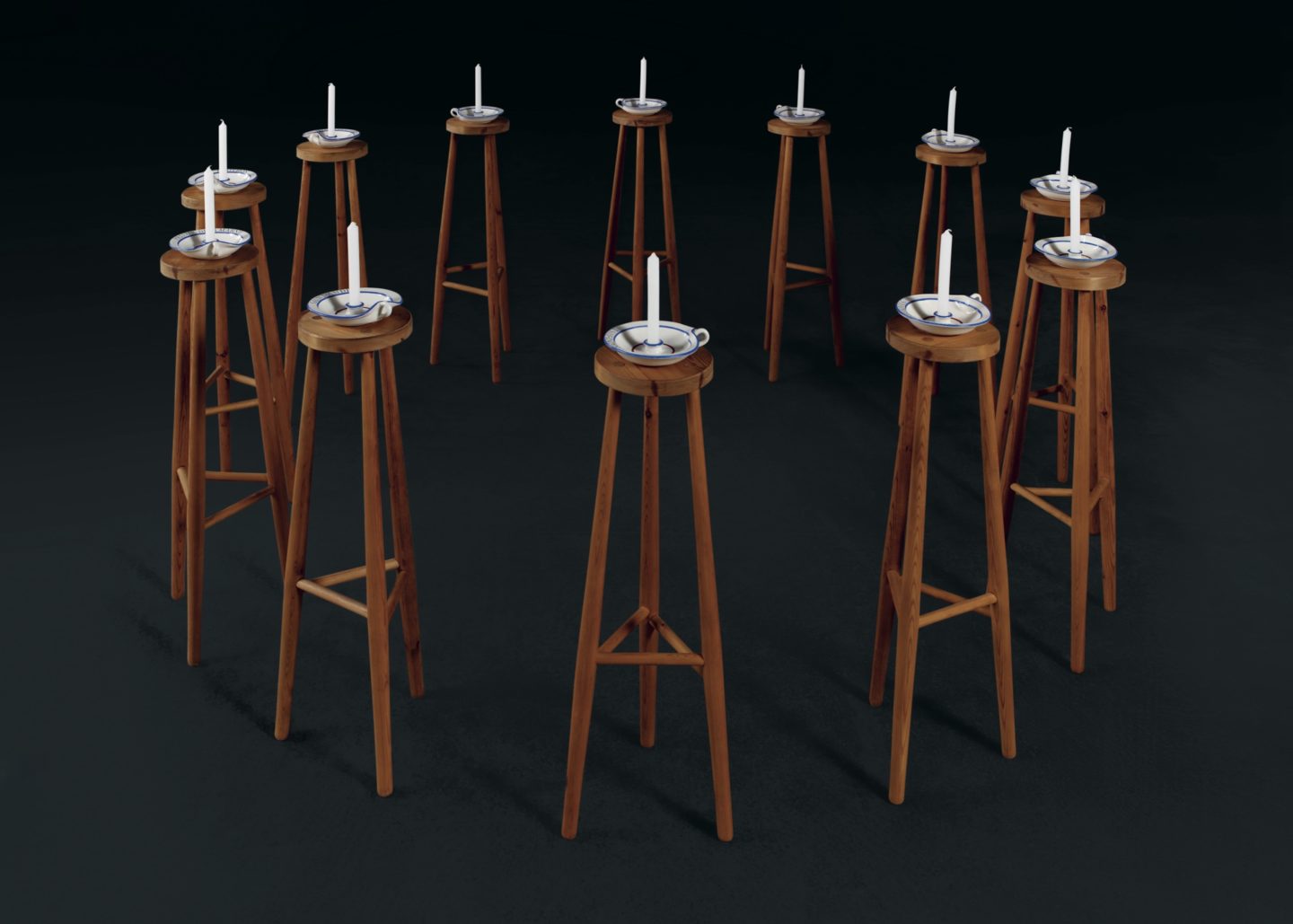
12 ceramic candlesticks, each on wooden stools, with Katherine and Candida Ballantyne and Caroline Webb
Candlesticks each: 5.5 x 18 x 18.5 cm, 2 1/8 x 7 1/8 x 7 1/4 in
Stools each: 96 x 33 x 33 cm, 37 3/4 x 13 x 13 in
Ian Hamilton Finlay, 12 / 1794, 1994
More info‘Finlay’s night scene evokes the [Committee of Public Safety] with twelve named candlesticks.’ — Stephen Bann, from the accompanying publication
This work is one of a number by Finlay that refer to the Committee of Public Safety, which controlled France during the period of the Revolution that followed the deposition of King Louis XVI. The committee comprised the same twelve members from September 1793 to July 1794, when several were guillotined.
Stephen Bann writes, ‘No group painting exists of the doomed members of the Committee of Public Safety. The French author, Pierre Michon, has recently devised the fiction of such a secular “Last Supper” being completed, more famous than David’s Marat, and an inspiration for the historian of the Revolution, Jules Michelet. In 1969, the Greek artist, Jannis Kounellis, installed a lighted candle before a blackboard with the slogan, “Liberty or Death”, and the names Marat and Robespierre chalked upon it. Finlay’s night scene evokes the committee with twelve named candlesticks.’
Finlay (Marat and Unwanted Shadow) 2 x carvings
‘IRONY, in its immediate application, could refer to the fact that Lepeletier, in voting for the death of the King, inadvertently brought about his own death; or it could refer to the fate of the original David painting, which is ironic enough.’ — Ian Hamilton Finlay, from the accompanying publication
Two carved-stone wall sculptures, Head of the Dead Marat and Irony n. The Unwanted Shadow, both completed in 1991, refer to Jacques-Louis David’s 1793 portraits of revolutionary martyrs, The Death of Marat and The Last Moments of Michel Lepeletier. While The Death of Marat is in the collection of Royal Museum of Fine Arts of Belgium, The Last Moments of Michel Lepeletier, which showed Lepeletier on his deathbed following his assassination for voting in favour of the execution of Louis XVI, is untraceable.
In a letter to Neil Talbot, Finlay wrote, ‘The work I have in mind is David’s painting of the dead Lepeletier, though we have to work from drawings of the painting, because of its curious history … JE VOTE LA MORT DU TYRAN was the text on the bit of paper transfixed by the sword. In my proposal, the paper is left empty, an emptyness which should be striking enough to suggest that the text which is now placed at the top of the relief, originally belonged there. This text would read: IRONY, n. THE UNWANTED SHADOW. SHADOW will seem to refer to the suspended sword, which threatens the figure. IRONY, in its immediate application, could refer to the fact that Lepeletier, in voting for the death of the King, inadvertently brought about his own death; or it could refer to the fate of the original David painting, which is ironic enough.’
Finlay (Republic) watering cans/drums
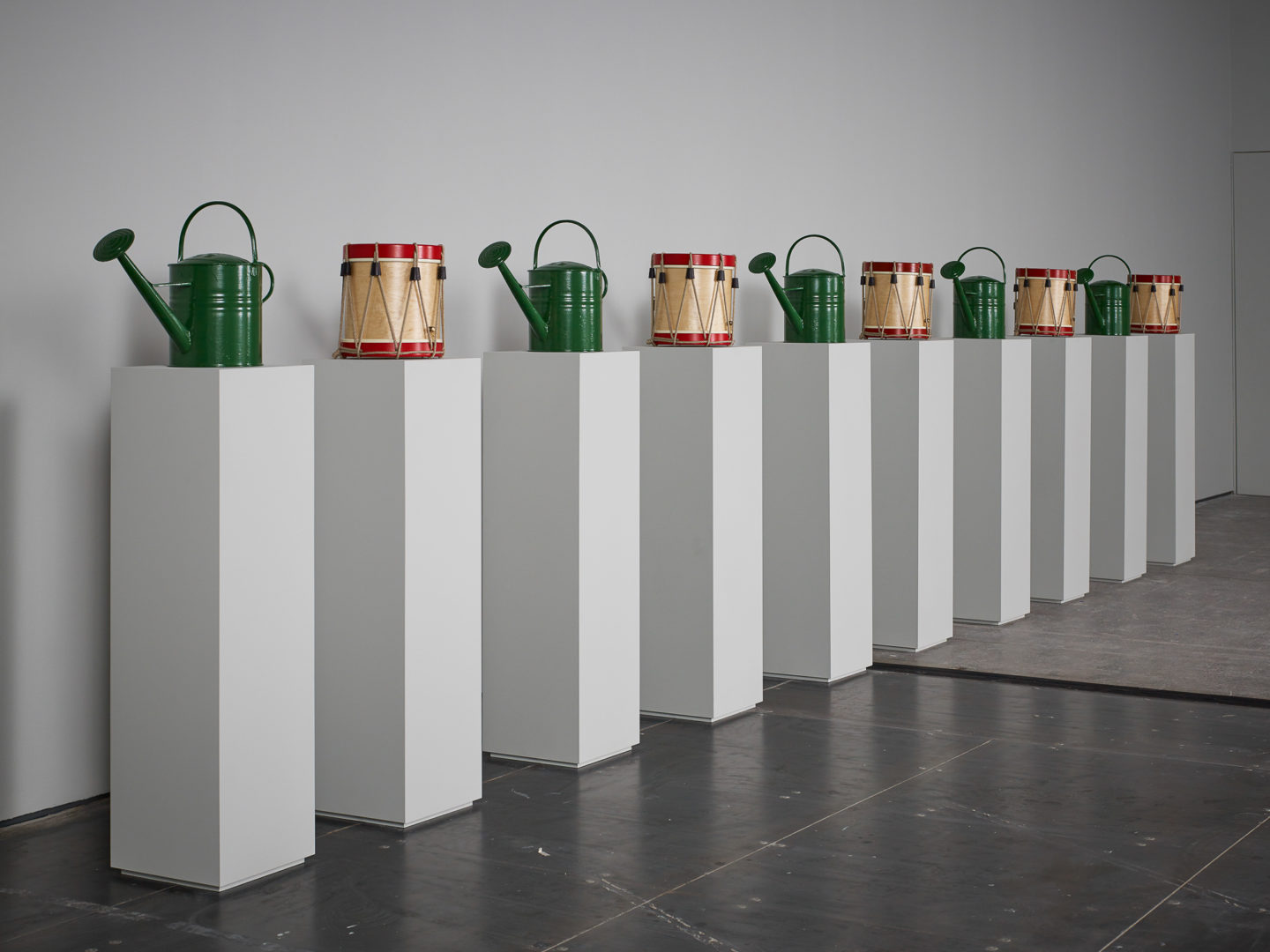
Five painted metal watering cans and five wooden drums
Watering cans each: 39 x 56 x 23 cm, 15 3/8 x 22 1/8 x 9 1/8 in
Drums each: 30 x 30 cm, 11 3/4 x 11 3/4 in diameter
Ian Hamilton Finlay, Republic, 1995
More info‘…“Arrosoir” [watering-can] is also the republican name for the day of the month on which Robespierre was guillotined. The drums derive their poignant associations from the wars that put at risk the French Revolution.’ — Stephen Bann, from the accompanying publication
Republic embodies the multiple connections and meanings in Finlay’s art that arise from even apparent simple juxtapositions, aligning with Tom Lubbock’s comment that ‘It has the breadth of response that a mature art should have. It straddles the grand and the severe, praise, wonder, militant ferocity, elegy, idyll, wit, sweetness, daft jokes. It is a world.’ In this instance, the formal placement of wooden drums interspersed with watering cans creates a rhythm in which the prosaic and poignant co-exist, alluding to one of the most influential and controversial figures of the French Revolution, Maximilien Robespierre (1758–1794).
Stephen Bann writes, ‘In respect of watering-cans, Finlay recalls the advice of an eighteenth-century poet. William Shenstone recommended the placing in gardens of “objects, perhaps not very striking, if they seem to connect ideas that convey relations of a pleasing kind“. But “Arrosoir” [watering-can] is also the republican name for the day of the month on which Robespierre was guillotined. The drums derive their poignant associations from the wars that put at risk the French Revolution. They serve as a tribute to Joseph Bara, the drummer boy whose dying moments were tenderly evoked in a painting by Jacques-Louis David.’
Finlay press quote (Frieze, Tom Morton)
‘…he deals in eternal things: love, war, myths, faith and, of course, the sea – what could be more timeless than that?’ — Tom Morton, Frieze
Finlay (2 x neons)
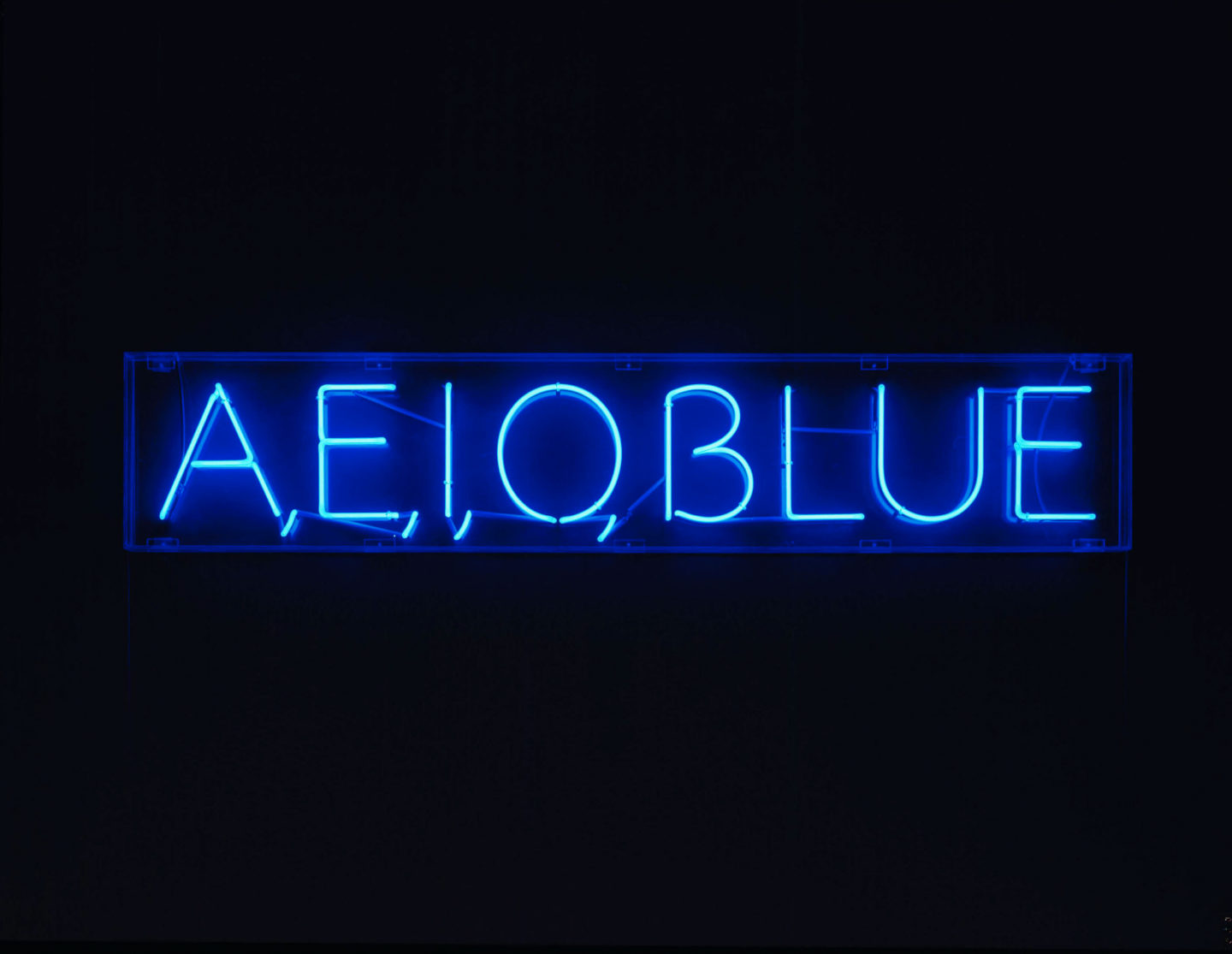
Neon, with Julie Farthing
33.5 x 151 x 6.5 cm
13 1/4 x 59 1/2 x 2 1/2 in
Ian Hamilton Finlay, A, E, I, O, Blue, 1992
More info‘Loosely speaking a vowel is just voiced breath, sound made with an unconstricted vocal tract, coloured by its shaping; with no friction, any more than there is in the movement of light.’ — Harry Gilonis, from the accompanying publication
Finlay’s rarely seen neon works date back to the early 1970s and run parallel to his better-known inscriptions in stone, extending his poetic ideas beyond the printed page to become objects in the world. Often, Finlay’s works stretch outwards from the immediacy of language in the here and now towards the immensity of nature or, temporally, to the infancy of philosophical thought. In the 1992 neon A, E, I, O, Blue, while the initial letters are the first four vowels of the English alphabet, the sequence is completed not by the final vowel – U – but by the word ‘blue’, which creates a rhyme on its pronunciation, complemented by the colour of the work, as well as a corresponding sense of vastness.
Harry Gilonis writes, ‘A,E,I,O,BLUE is a text written in light, suffusing and filling its space. Four vowels – and by implication a fifth, included in the final word and rhyming with it. Loosely speaking a vowel is just voiced breath, sound made with an unconstricted vocal tract, coloured by its shaping; with no friction, any more than there is in the movement of light. Finlay’s text re-configures half the opening line of an 1871 sonnet, ‘Voyelles’, by Arthur Rimbaud, a work absolutely modern despite being written in classical alexandrines: “A noir, E blanc, I rouge, U vert, O bleu: voyelles, Je dirai quelque jour vos naissances latentes…” [A black, E white, I red, U green, O blue: vowels, Some day I shall speak of your hidden origins…] Finlay evades the complex and still contested questions of the rationales for Rimbaud’s colour-associations, for their plausibility: leaving us in a space saturated with colour, its BLUE vowel re-echoing and re-echoing.’
Finlay (Proem)
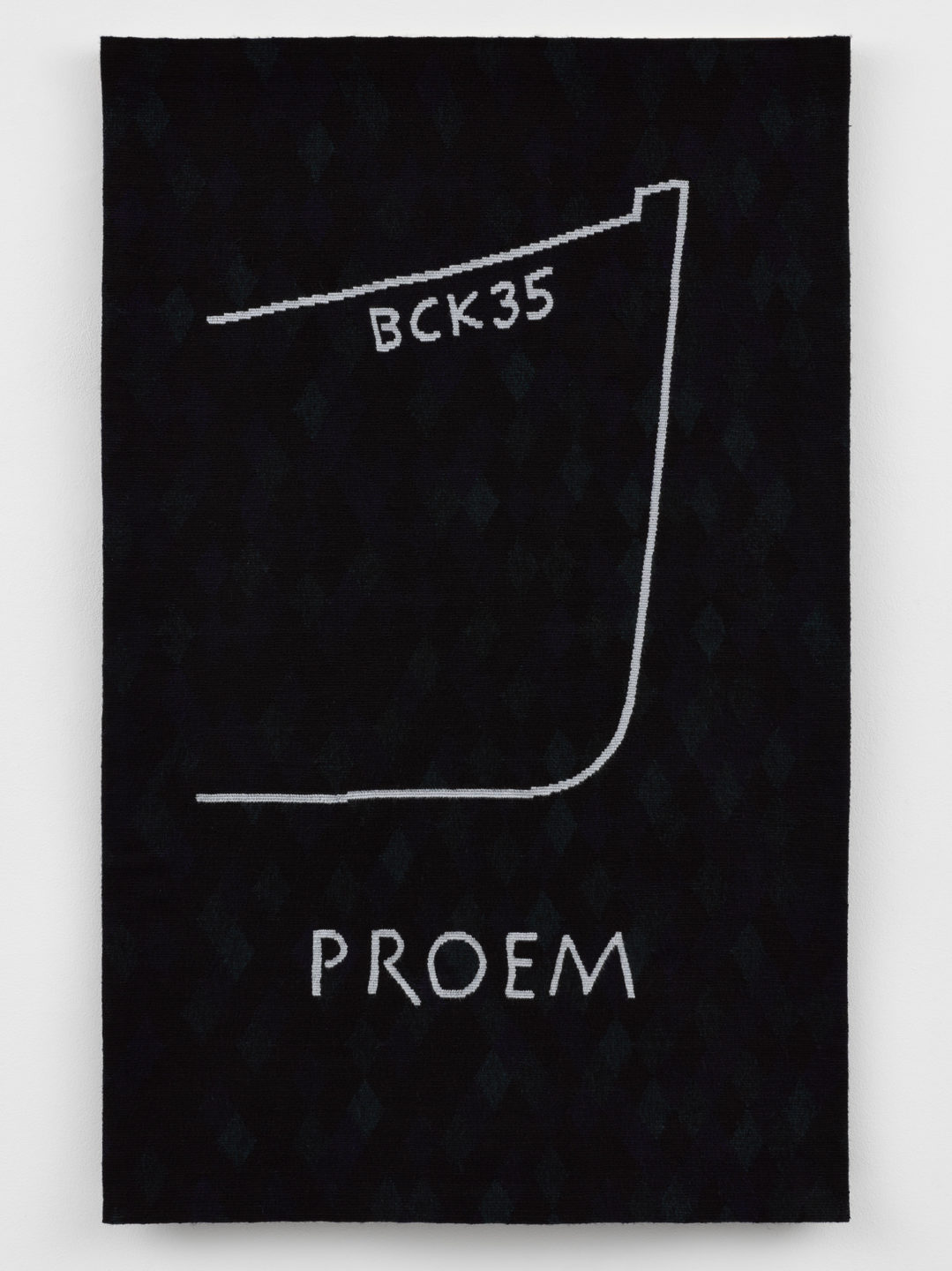
Wool tapestry, with Ron Costley
139 x 88.5 cm
54 3/4 x 34 7/8 in
Ian Hamilton Finlay, Proem, 1998
More info‘A minimal work, with a quite maximal cargo.’
— Harry Gilonis, from the accompanying publication
The tapestry Proem, 1998, distils a visual and linguistic pun (poem/prow) and also makes reference to the classification numbers of fishing boats (in this instance, BCK35, signifying Buckie in the Moray Firth).
Harry Gilonis writes, ‘A minimal work, with a quite maximal cargo. There’s a boat’s prow in stylised profile; by synecdoche it stands for the whole vessel. It bears her port-registration letters: BCK 35. One might stop there; who, reading Homer’s “list of ships”, actually wonders where, say, “Asine’ once was? But for the curious, Finlay’s favourite Olsen’s Fisherman’s Nautical Almanack lists the Hazelgrove, a trawler out of Buckie on the Moray Firth – Finlay made another work referring to her by name. Below her outlined prow, in the same stylised, slightly-Greek lettering, we read “PROEM”: the part of a spoken or written text that comes first. [In its way, a verbal prow; reciprocally, Finlay has elsewhere added words to a rudder.] It’s from the Greek; pro-, “before”, plus – lexicographers disagree – “way, or road”; or, maybe, “song”. Here, then, our prow/poem starting out, going her way on the sea’s road. Poetry, in Greek, is “making”; here is the Hazelgrove beginning the song of her doing, of her making.’
Finlay (flat top tombstone)
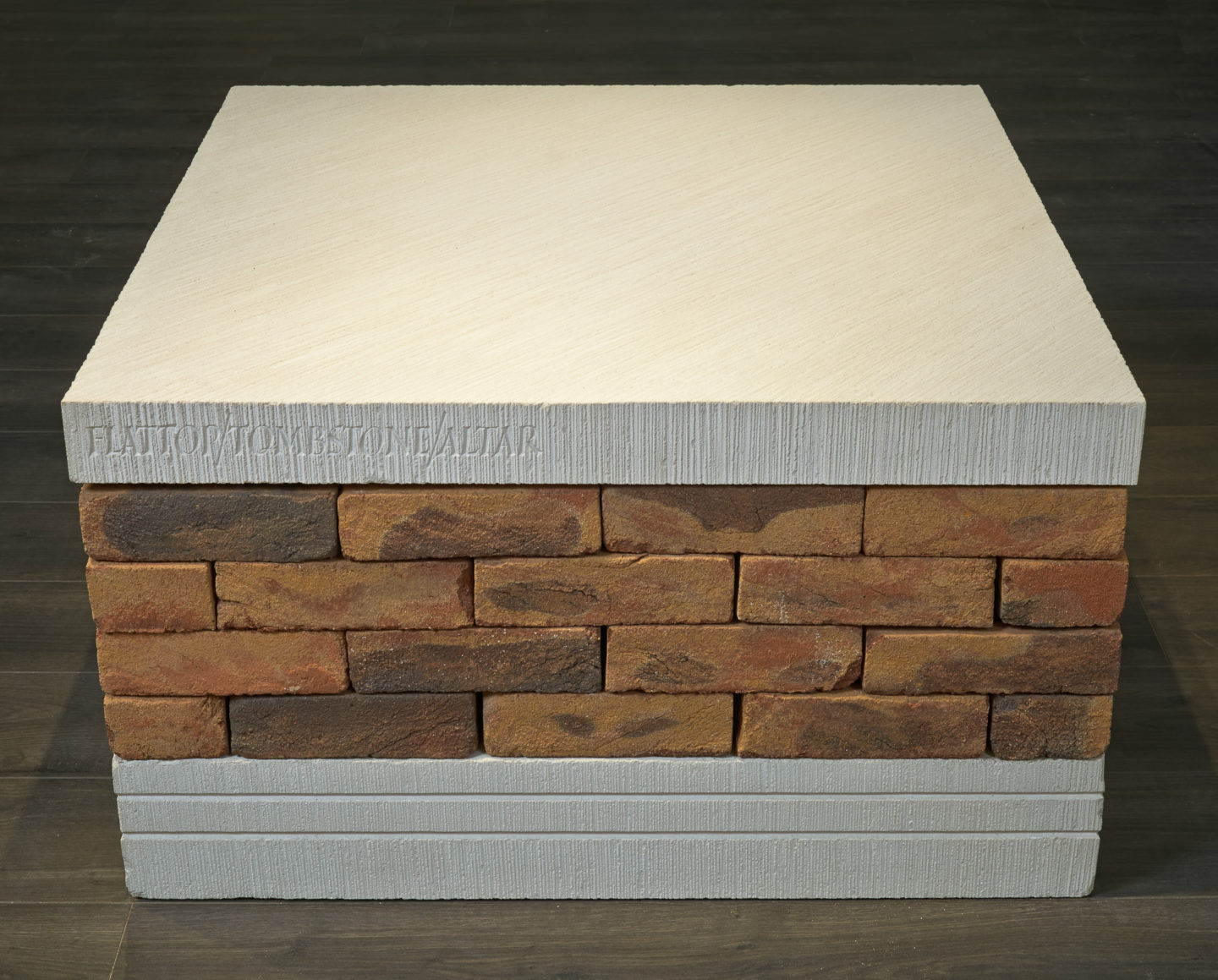
Bricks and Portland stone, with Nicholas Sloan
48 x 86 x 86 cm
18 7/8 x 33 7/8 x 33 7/8 in
Ian Hamilton Finlay, Flattop / Tombstone / Altar A Place / For Light / To Land, 1987
More info‘The simple message carved at its edges attests that this is where ‘light’ will land. Light will illuminate the square surface of the cubic structure which faces up to the sky [altar], but also turns downwards to the earth [tomb].’ — Stephen Bann, from the accompanying publication
‘The term ‘flat-top’ has a specific meaning here, since it is being used to evoke the particular mark of aircraft-carrier which has been equipped with a ‘flat-top’ flight-deck. Such flat decks were employed both to launch and to recover the aircraft. One of Finlay’s early garden features was his “Aircraft-carrier birdtable”, which harboured a small pool of refreshing water. He also composed an emblem which invested the nuclear aircraft-carrier with an exemplary role, as it was a “celebration of earth, air, fire and water”. In this case, the flat polished surface is exposed to the sky. The simple message carved at its edges attests that this is where “light” will land. Light will illuminate the square surface of the cubic structure which faces up to the sky [altar], but also turns downwards to the earth [tomb].’
Finlay (Seven Ship’s Bells)

Brass bell and rope, with John Andrew
20.4 x 55 x 21.6 cm
8 x 21 5/8 x 8 1/2 in
Ian Hamilton Finlay, Ship’s Bells (Iroko wrap-around – strake), 2002
More infoIan Hamilton Finlay: Fragments takes place in May 2025 at: Ingleby Gallery, Edinburgh; Kewenig Gallery, Palma de Mallorca; Galleria Massimo Minini, Brescia; Victoria Miro, London; David Nolan Gallery, New York; Sfeir-Semler Gallery, Hamburg; Stampa Galerie, Basel; Galerie Hubert Winter, Vienna.
Ian Hamilton Finlay: Fragments publication
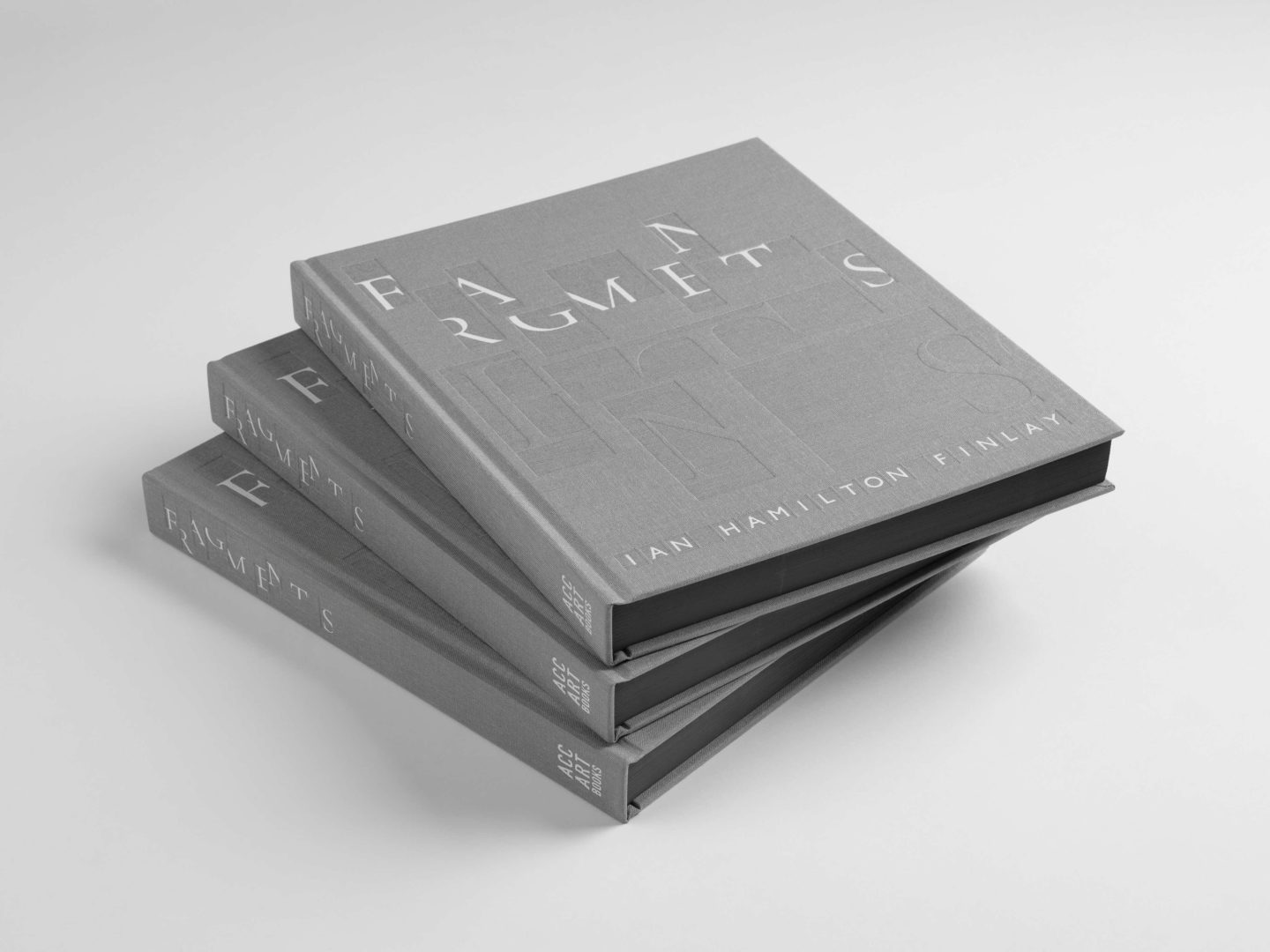
Published by ACC Art Books
Price £50
Ian Hamilton Finlay, Fragments publication
More infoPublished on 8 May 2025 by ACC Art Books and edited by Pia Maria Simig, Fragments draws together 100 works by Ian Hamilton Finlay, each accompanied by a short, fragmentary text by the artist and myriad distinguished writers who wrote about Finlay’s work during his lifetime. It features introductory essays by Stephen Bann (CBE, Emeritus Professor of History of Art at the University of Bristol) and Tom Lubbock (chief art critic of The Independent from 1997 until his death in 2011) and includes 100 full colour plates. Additional texts by: Yves Abrioux, Stephen Bann, Prudence Carlson, Patrick Duncombe, Julia Eames, Patrick Eyres, Alec Finlay, Ian Hamilton Finlay, George Gilliland, Harry Gilonis, and Tom Lubbock.
About the artist
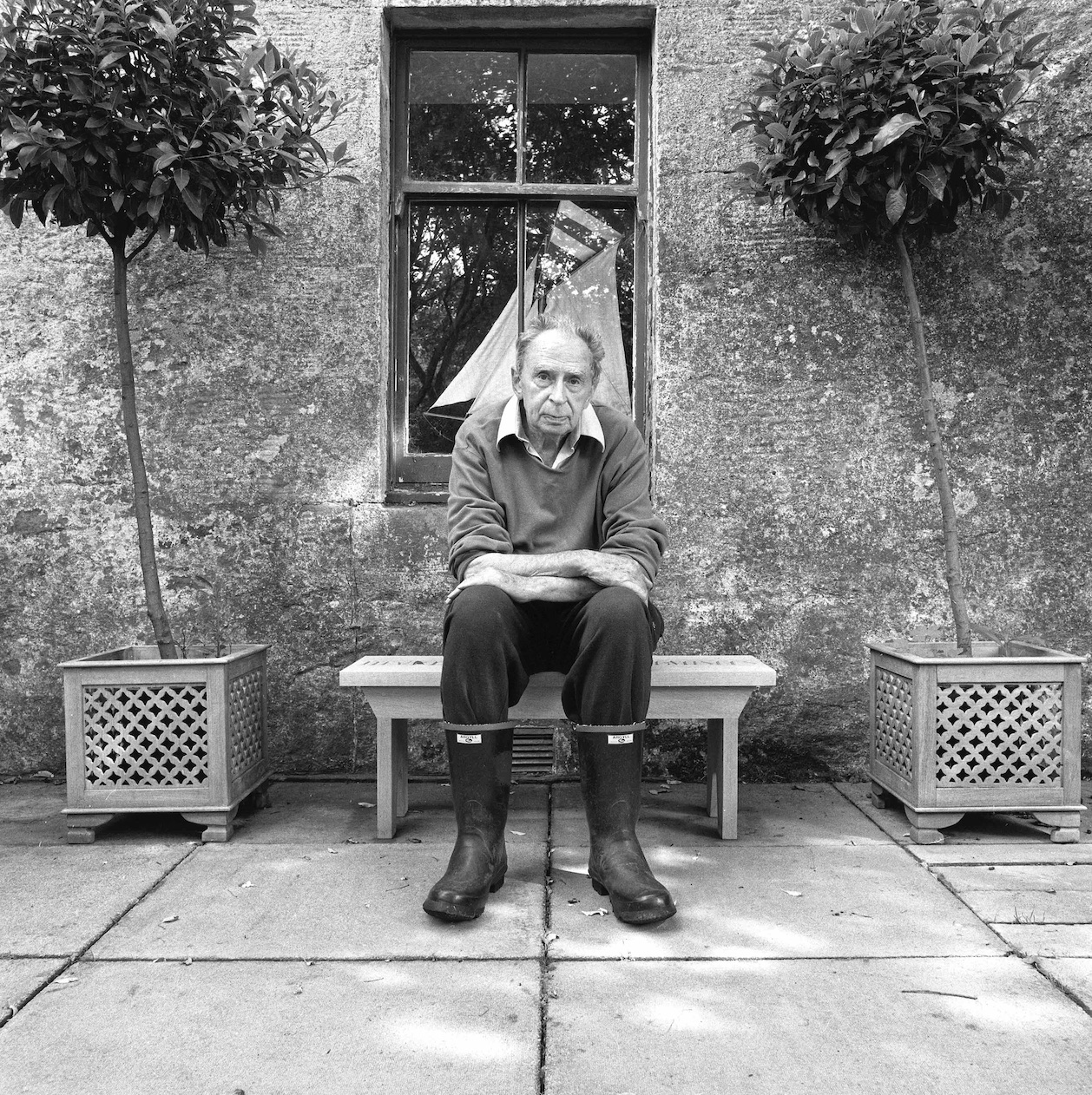
Born in 1925 in Nassau, Bahamas, Ian Hamilton Finlay was a philosopher, sculptor and poet who reinvigorated the classical tradition in his art. Finlay’s diverse production encompassed a variety of creative forms including prints, poems, books, inscriptions, neons, sculptures, permanent installations and landscape design, all celebrating the sustaining power of words. The purest kind of conceptual artist, Finlay was sensitive to the formalist concerns (colour, shape, scale, texture, composition) of literary and artistic modernism. In 1961 he founded Wild Hawthorn Press with Jessie McGuffie, mainly to introduce contemporary artists to Scotland, and which over the years came to concentrate exclusively on Finlay’s printed works. His lifetime’s work, the garden at Little Sparta, Stonypath, Scotland, begun in 1966, most fully realises the movement of words and language into the world. Ian Hamilton Finlay died 27 March 2006, aged 80.
Recent solo exhibitions include The Scottish National Gallery of Modern Art, Edinburgh, UK (2025); Hill Art Foundation, New York, USA (2024); City Arts Centre, Edinburgh, UK (2021); St Pauls Cathedral, London, UK (2016) and Pallant House Gallery, Chichester, UK (2016).
Finlay’s work is in permanent collections including the British Museum, London; Kelvingrove Art Gallery and Museum, Glasgow; Laumeier Sculpture Park, St Louis, USA; Museum of Modern Art, New York; Musée d’Art Moderne de Paris, Paris; Scottish National Gallery, Edinburgh; Scottish National Gallery of Modern Art, Edinburgh; Tate, London and Victoria & Albert Museum, London.
